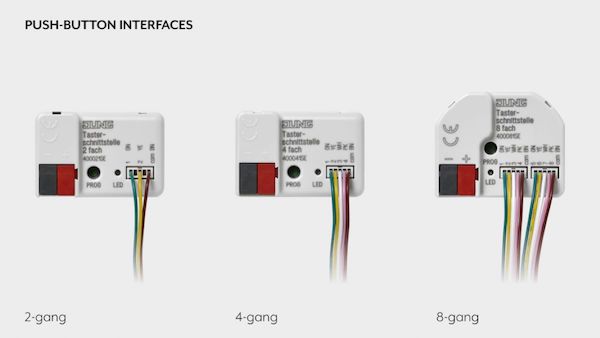The new push-button interfaces from JUNG offer an optimum solution for the integration of sensors and switches in the KNX system. Building owners benefit from more security and energy efficiency. Thanks to the compatibility with KNX Data Secure, the push-button interfaces are tamper-proof. They can also be updated with the JUNG KNX Service App.
Seamless integration of various functions
Push-buttons, door or window sensors, hotel card or key switches can be easily integrated into the KNX system via the floating contacts. This enables intelligent control of lighting, heating, air conditioning and other electrical devices. Another major advantage of the new push-button interface is its versatility. It supports leakage and condensation sensors as well as temperature sensors and door and window contacts. This allows building owners to increase the security and energy efficiency of their building.

Three different versions with KNX Secure
With two, four or eight independent channels, the installer can parameterise each channel as an input or output. The push-button interface can also send telegrams to the bus based on read-in push-button/switch statuses. This enables precise and reliable control of the connected devices. Neighbouring input channels can be combined when push-buttons, door or window contacts are connected. This allows complex logic functions to be realised. It is also possible to block individual channels of the push-button interface. This enables targeted control and management of the connected devices. Another advantage of the new push-button interface is its compatibility with KNX Data Secure. This offers a high level of tamper protection in building automation and can be easily configured via the project design in the ETS. The devices can be updated and can be conveniently supplied with firmware updates via the Jung ETS Service app.
Versatile options for setting up the KNX system
- With the new KNX push-button interface, various switch types such as installation switches, push-buttons, reed contacts (door/window contacts), leakage/condensation sensors, temperature sensors, Mini Basic motion detectors, pulse counters and outputs can be integrated into the KNX system.
- In a hotel, the KNX push-button interface with the FFNTC temperature sensor can be used in a variety of ways. For example, it automatically adjusts the room temperature in hotel rooms and thus offers guests optimum comfort.
- By integrating leakage and condensation sensors into the KNX system, the push-button interface enables reliable monitoring and early warning of moisture and water damage. This allows measures to be taken to minimise damage and warranty the safety of the building.
- By connecting reed contacts to the push-button interface, users can monitor the status of doors and windows.
- The push-button interface has a pulse counter with main and intermediate counters. This enables the accurate recording and monitoring of pulses, for example for measuring energy consumption or recording meter readings.












